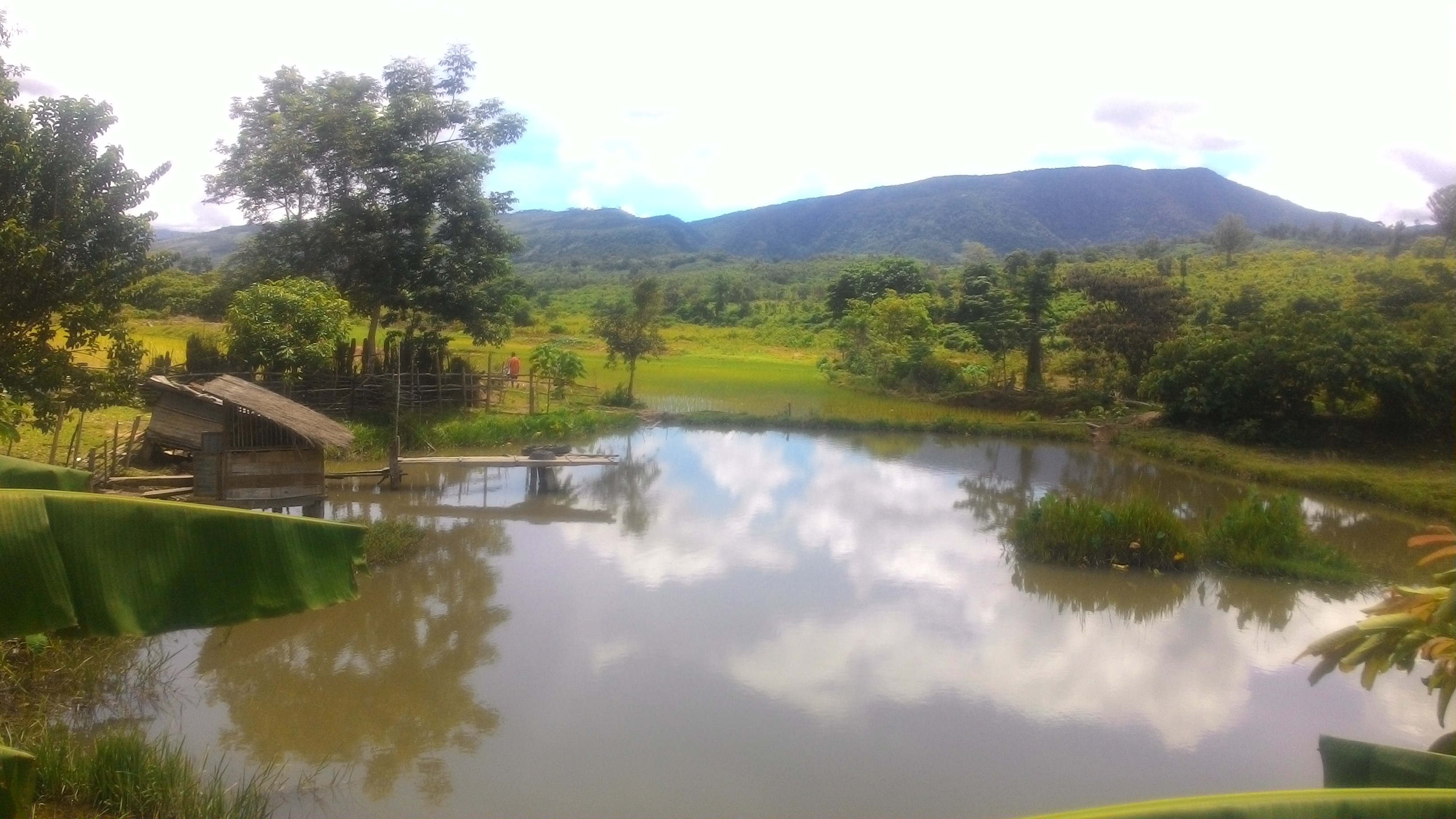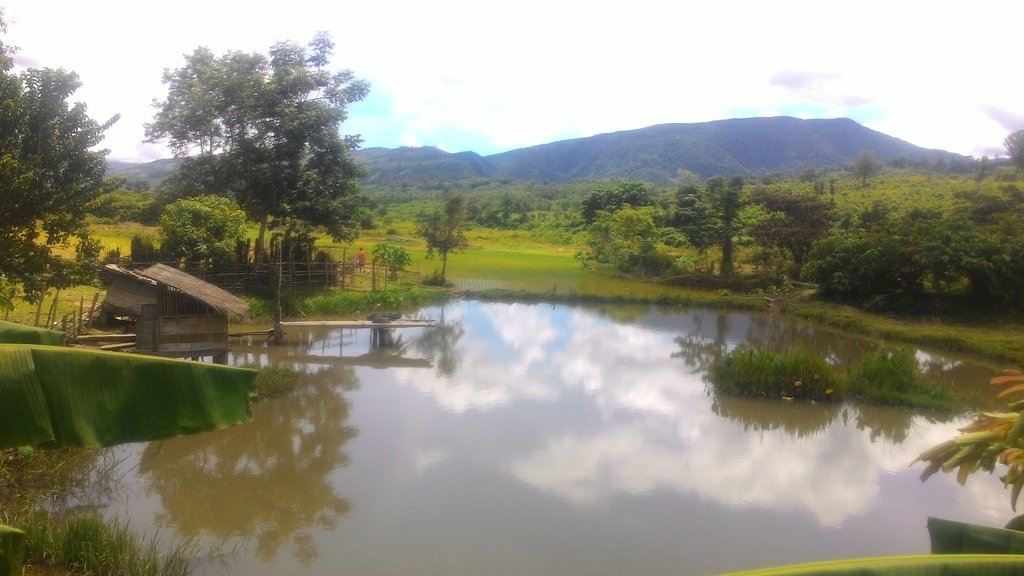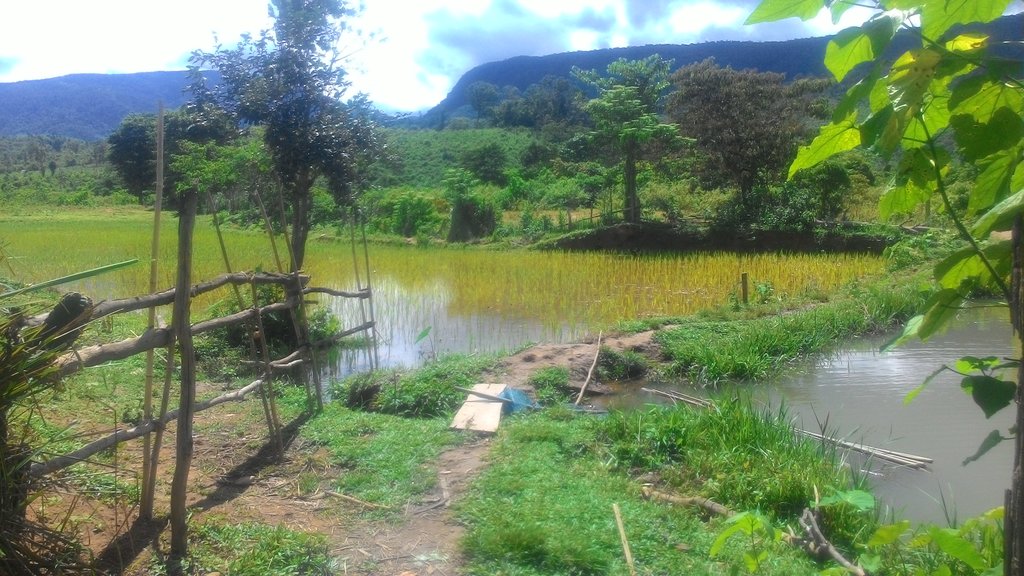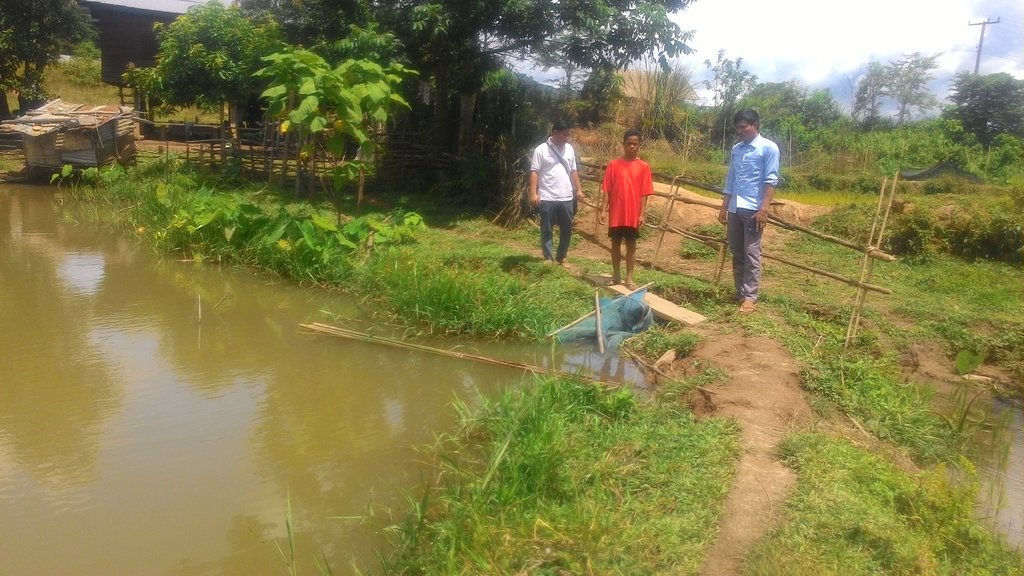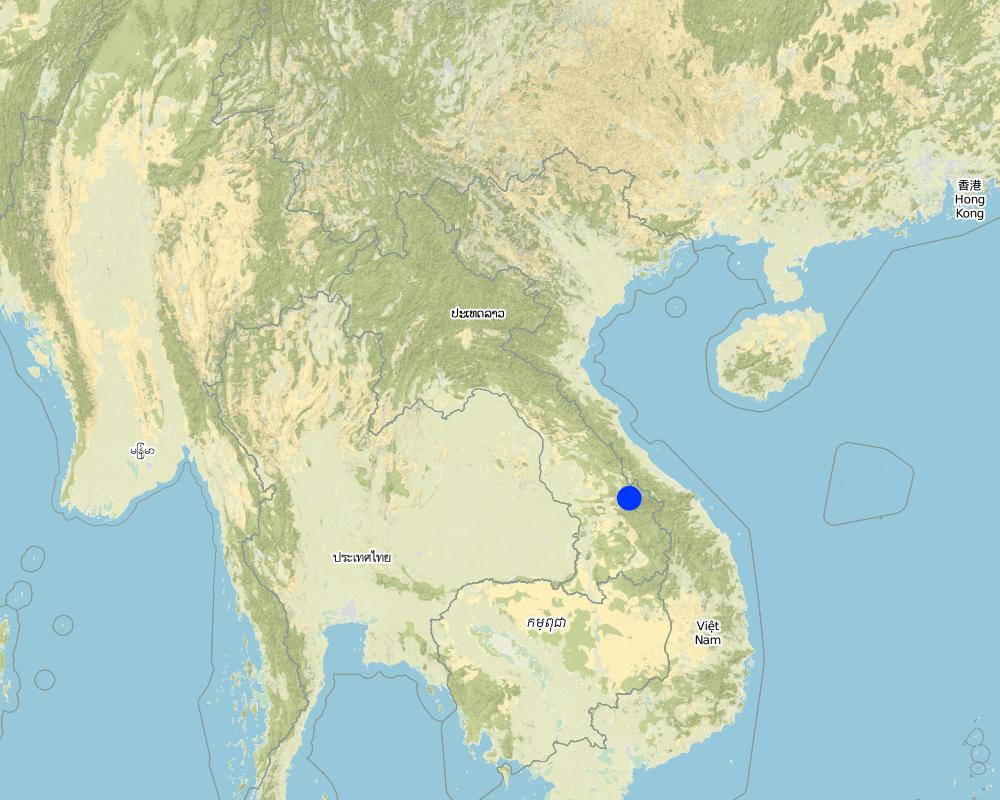ເຕັກນິກການໃຊ້ນ້ຳຈາກໜອງປາໃສ່ນາເຂົ້າ [Lao People's Democratic Republic]
- Creation:
- Update:
- Compiler: jimmy luangphithack
- Editors: Bounthanom Bouahom, Pasalath Khounsy, anousit namsena, kang phanvongsa
- Reviewers: Oulaytham Lasasimma, Stephanie Jaquet, Nicole Harari
technologies_2923 - Lao People's Democratic Republic
View sections
Expand all Collapse all1. General information
1.2 Contact details of resource persons and institutions involved in the assessment and documentation of the Technology
Key resource person(s)
land user:
ມວດ ທ້າວ ອຳນ້ອຍ
030 9137108
ບ້ານ ດູບ ເມືອງຕະໂອ້ຍ
Lao People's Democratic Republic
Name of project which facilitated the documentation/ evaluation of the Technology (if relevant)
Scaling-up SLM practices by smallholder farmers (IFAD)Name of the institution(s) which facilitated the documentation/ evaluation of the Technology (if relevant)
National Agriculture and Forestry Research Institute (NAFRI) - Lao People's Democratic Republic1.3 Conditions regarding the use of data documented through WOCAT
When were the data compiled (in the field)?
11/07/2017
The compiler and key resource person(s) accept the conditions regarding the use of data documented through WOCAT:
Ja
1.4 Declaration on sustainability of the described Technology
Is the Technology described here problematic with regard to land degradation, so that it cannot be declared a sustainable land management technology?
Nee
2. Description of the SLM Technology
2.1 Short description of the Technology
Definition of the Technology:
ເຕັກນິກການນຳໃຊ້ນຳໃນໜອງປາໃສ່ນາເຂົ້າ ເພື່ອຫຼຸດຜ່ອນການນຳໃຊ້ນ້ຳຊົນລະປະທານ ແລະ ຄວາມສ່ຽງຈາກໄພແຫ້ງແລ້ງ
2.2 Detailed description of the Technology
Description:
- ເຕັກນິກການນຳໃຊ້ນ້ຳໃນໜອງປາໃສ່ນາເຂົ້າ, ແມ່ນໄດ້ນຳໃຊ້ຢູ່ບ້ານດູບ ເມືອງຕະໂອ້ຍ ແຂວງສາລະວັນ ແລະປະຕິບັດຄັ້ງທຳອິດໃນປີ 2010 ແມ່ນໄດ້ບຸກເບີກເນື້ອທີ່ນາໃນເນື້ອທີ່ 0,5 ເຮັກຕາ, ສະນັ້ນໃນການເຮັດນາກໍ່ມີບັນຫາເລື່ອງການຂາດນ້ຳ ແລະ ກໍ່ສາມາດເຮັດນາໄດ້ພຽງລະດູດຽວກໍ່ຄືລະດູຝົນ, ແຕ່ພໍຮອດປີ 2012 ທາງຄອບຄົວຂອງ ທ້າວນອ້ຍ ກໍ່ໄດ້ມີຄວາມຄິດອັນໃໜ່ຂື້ນມາ, ໂດຍຍາກນຳໃຊ້ທີ່ດິນໃຫ້ເປັນປະໂຫຍດຫຼາຍຂື້ນ, ໂດຍໄດ້ມີການໄປຈ້າງລົດມາດຸດໜອງເພື່ອຈະລ້ຽງປາໃນເນື້ອທີ ກວ້າງ 30 ແມັດ, ຍາວ 50 ແມັດ, ເລີກ 1,50 ແມັດ, ນອກນັ້ນລາວຍັງໄດ້ນຳໃຊ້ນ້ຳຈາກໜອງທີ່ລຽງປາໄປທຳການຜະລິດປູກເຂົ້າໄດ້ທັງສອງລະດູການຄື: ລະດູແລ້ງ ແລະ ລະດູຝົນ, ຈາກນັ້ນໄດ້ມີການລະບາຍນ໊ຳດວ້ຍການຂຸດຮອ່ງນ້ຳຄວາມກວ້າງປະມານ 40cm, ເພື່ອບະບາຍນ້ຳໄປຟື້ນທຳການຜະລິດປູກເຂົ້າ.-ການນຳໃຊ້ເຕັກນິກນີ້ຍັງສາມາດໃຫ້ຜົນປະໂຫຍດເພີ່ມຜົນຜະລິດເຊັ່ນ: ປາ, ເຂົ້າ, ແລະ ເພື່ອຄ້ຳປະກັນທາງດ້ານສະບຽງອາຫານຂອງຄອບຄົວຕົນເອງ, ນອກນັ້ນຍັງສາມາດເຮັດໃຫ້ຟື້ນທີ່ທຳການຜະລິດປູກເຂົ້າມີຄວາມອຸດົມສົມບູນ, ມີຄວາມຊຸ່ມຕະຫຼອດປີ ແລະ ຍັງຫຼຸດຜ່ອນການນຳໃຊ້ນ້ຳຈາກຊົນລະປະທານອີກດ້ວຍ, ຍັງສາມາດຫຼຸດຜ່ອນການເຊາະເຈື່ອນຂອງດິນທີ່ເກີດຈາກການໄຫຼເຊາະຂອງນ້ຳປ່າ ເພາະວ່າ ການຂຸດໜອງປ່າ ຊ່ວຍໃນການເກັບກັກນ້ຳທີ່ໄຫຼມາຈາກປ່າ ບໍ່ໃຫ້ເຂົ້າສູ່ເຂດພື້ນທີ່ການຜະລິດ(ນາເຂົ້າ)ໂດຍກົງ ສະນັ້ນຟື້ນທີ່ດິນຕອນນັ້ນສາມາດທຳການຜະລິດປູກເຂົ້າໄດ້ຢ່າງຍາວນານ ແລະ ຫຼຸດຜ່ອນໄພແຫ້ງແລ້ງ, ການນຳໃຊ້ເຕັກນິກປ່ອຍນ້ຳໃນໜອງປາໃສ່ນາເຂົ້າຍັງມີຜົນກະທົບໃຫ້ແກ່ຜູ້ນຳໃຊ້ດິນຄື: ໜອງປາດັ່ງກ່າວ ແມ່ນຕ່ຳກວ່າພື້ນທີ່ການຜະລິດ ຈື່ງບໍ່ສາມາດນຳໃຊ້ນ້ຳຢ່າງທົ່ວເຖີ່ງ ຜ່ານການນຳໃຊ້ເຕັກນິກດັ່ງກ່າວເຫັນວ່າຜູ້ນຳໃຊ້ທີ່ດິນ ມີຄວາມເພີ່ງພໍໃຈຫຼາຍ ໃນເບື້ອງຕົ້ນ ເພາະສາມາດນຳໃຊ້ນ້ຳເຮັດນາໄດ້ທັງ 2 ລະດູການເຊັ່ນ: ລະດູແລ້ງ ແລະ ລະດູຝົນ, ສາມາດເພີ່ມຜົນຜະລິດໄດ້ຫຼາຍຂື້ນກວ່າເກົ່າ(ຜະລິດເຂົ້າ) ,ຍັງສາມາດລ້ຽງປາ ເພື່ອຕອບສະໜອງຊິວີດການເປັນຢູ່ຂອງຕົນເອງໄດ້ ແລະ ເຮັດໃຫ້ດິນທີ່ທຳການຜະລິດມີຄວາມຊຸ່ມຊື່ນ ບໍ່ແຂງ ແລະ ແຫ້ງແລ້ງເໝືອນແຕ່ກ່ອນ.ຈຸດດີ: (1) ການນຳໃຊ້ນ້ຳ ຈາກໜອງການນໍາໃຊ້ນ້ໍາຈາກໜອງປາ ເພື່ອໃຫ້ການປູກເຂົ້າໃນລະດູແລ້ງ ແລະ ລະດູຝົນເຊິ່ງເຮັດໃຫ້ ກິດຈະກໍາ ການກະສິກໍາບໍ່ມີການນໍາໃຊ້ນ້ໍາ ຈາກລະບົບຊົນລະປະທານ. 2. ສາມາດລ້ຽງ ແລະ ຂະຫຍາຍພັນປາຈຸດອ່ອນ: (1) ລະດັບໜອງປາ ແມ່ນ ຕ່ໍາກວ່າທີ່ດິນກະສິກໍາ ແລະ ສະນັ້ນການປູກເຂົ້າສາມາດດໍາເນີນໃນພື້ນທີ່ຈໍາກັດໂດຍຜ່ານການໄຫຼຂອງນ້ຳ; (2) ປັ໊ມນ້ໍາມັນກາຊວນ ແມ່ນ ຈໍາເປັນເພື່ອສະຫນອງນ້ໍາໃນການປູກເຂົ້າ
2.3 Photos of the Technology
2.5 Country/ region/ locations where the Technology has been applied and which are covered by this assessment
Country:
Lao People's Democratic Republic
Region/ State/ Province:
ສາລະວັນ
Further specification of location:
ບ້ານ ດູບ ເມືອງຕະໂອ້ຍ
Map
×2.6 Date of implementation
Indicate year of implementation:
2012
If precise year is not known, indicate approximate date:
- less than 10 years ago (recently)
2.7 Introduction of the Technology
Specify how the Technology was introduced:
- through land users' innovation
3. Classification of the SLM Technology
3.1 Main purpose(s) of the Technology
- improve production
- reduce, prevent, restore land degradation
- reduce risk of disasters
3.2 Current land use type(s) where the Technology is applied

Cropland
- Annual cropping
Main crops (cash and food crops):
ປູກເຂົ້ານາປີ ແລະ ນາແຊງ

Waterways, waterbodies, wetlands
- Ponds, dams
Main products/ services:
ຜະລິດປາ ແລະ ນຳໃຊ້ນ້ຳຈາກເພື່ອຜະລິດເຂົ້
3.3 Further information about land use
Water supply for the land on which the Technology is applied:
- mixed rainfed-irrigated
Number of growing seasons per year:
- 2
Specify:
ນາປີ ແລະ ນາແຊງ
Livestock density (if relevant):
ປ່ອຍແນວພັນປາ ຈຳນວນ 1000ໂຕ
3.4 SLM group to which the Technology belongs
- water harvesting
- irrigation management (incl. water supply, drainage)
- beekeeping, aquaculture, poultry, rabbit farming, silkworm farming, etc.
3.5 Spread of the Technology
Specify the spread of the Technology:
- applied at specific points/ concentrated on a small area
3.6 SLM measures comprising the Technology

structural measures
- S5: Dams, pans, ponds
- S7: Water harvesting/ supply/ irrigation equipment

management measures
- M1: Change of land use type
3.7 Main types of land degradation addressed by the Technology

soil erosion by water
- Wg: gully erosion/ gullying
3.8 Prevention, reduction, or restoration of land degradation
Specify the goal of the Technology with regard to land degradation:
- prevent land degradation
- reduce land degradation
4. Technical specifications, implementation activities, inputs, and costs
4.1 Technical drawing of the Technology
Author:
ພອນສີລິ ພັນວົງສາ
Date:
11/07/2017
4.2 Technical specifications/ explanations of technical drawing
ໜອງປາແມ່ນມີຄວາມຍາວ 50 ແມັດ, ກວ້າງ 20 ແມັດ ແລະ ມີຄວາມເລີກ 1,5 ແມັດປະຕູນ້ຳມີຂະໜາດ 40 x 40 ຊັງຕີແມັດ ເຮັດດ້ວຍ ໄມ້ແປ້ນໄລຍະຫ່າງຈາກໜອງ ຫາ ນາ ແມ່ນ ໜອງຖືກສ້າງຂ້ືນ ຢູ່ຕິດກັນກັບນາ ມີພຽງຄັນຄູ ມີຄວາມກວ້າງ 40 ຊັງຕີແມັດ ຂັ້ນໄວ້.ໃຊ້ຈັກດູດນ້ຳ ຂະໜາດ 5 ແຮງ ເພື່ອໂປມນ້ຳເຂົ້ານາ ທີ່ມີເນື້ອທີ່ທັງໝົດ 0,5 ເຮັກຕາ ແລະ ມີຄວາມຄ້ອຍຊັນ 3-5% (ເປັນລັກສະນະ ນາຂັ້ນໄດ)ແນວພັນປາທີ່ໃຊ້ ລ້ຽງມີ ປານິນ, ປາໃນ, ປາກິນຫຍ້າ ເນື້ທີ່ຂອງໜອງ ສາມາດເກັບນ້ຳໄດ້ ປະມານ 2,000 ແມັດກ້ອນ, ຈາກນ້ຳທີ່ ໄຫຼມາຕາມຮ່ອງທີ່ ປະຊາຊົນສ້າງຂ້ືນ, ໂດຍຂຸດເປັນທາງນ້ຳ ຈາກຮ່ອງລົງສູ່ໜອງອີກຕ່ໍໜ່ືງປ້ຳນ້ຳ 5 ແຮງມ້າ, ແລະ ທ່ໍນ້ຳຍາວ 10 ແມັດ
4.3 General information regarding the calculation of inputs and costs
Specify how costs and inputs were calculated:
- per Technology unit
Specify unit:
ໜອງປາ
Specify volume, length, etc. (if relevant):
ຍາວ 50 ແມັດ, ກວ້າງ 20, ເລິກ 1,5 ແມັດ
other/ national currency (specify):
ກີບ
Indicate exchange rate from USD to local currency (if relevant): 1 USD =:
8000.0
Indicate average wage cost of hired labour per day:
50000 ກີບ
4.4 Establishment activities
| Activity | Type of measure | Timing | |
|---|---|---|---|
| 1. | ການຂຸດຫນອງ (ການນໍາໃຊ້ເຄື່ອງຂຸດ) | Structural | ເດືອນ 4 |
| 2. | ປ້ານຄັນນາ | Structural | ເດືອນ 4 |
| 3. | ຂຸດຮ່ອງນ້ໍາຈາກຫ້ວຍໄປສູ່ຫນອງ | Structural | ເດືອນ 4 |
| 4. | ສ້າງປະຕູໄມ້ | Structural | ເດືອນ 4 |
| 5. | ເອົານ້ໍາເຂົ້າຫນອງ | Other measures | ເດືອນ 5 |
| 6. | ຕິດຕັ້ງປັ໊ມແລະທໍ່ສໍາລັບການໂປ້ມນ້ຳເຂົ້ານາ | Management | ເດືອນ 5 |
4.5 Costs and inputs needed for establishment
| Specify input | Unit | Quantity | Costs per Unit | Total costs per input | % of costs borne by land users | |
|---|---|---|---|---|---|---|
| Labour | ແຮງງານຈ້າງ | ຄົນ | 6.0 | 50000.0 | 300000.0 | 100.0 |
| Labour | ແຮງງານສໍາລັບການຂຸດຂຸມຄອງຈາກນ້ໍາຫ້ວຍໄປສູ່ຫນອງ | ຄົນ | 5.0 | 50000.0 | 250000.0 | 100.0 |
| Labour | ແຮງງານສໍາລັບການຕື່ມນ້ໍາເຂົ້າໄປໃນຫນອງ, ການຕິດຕັ້ງປັ໊ມແລະທໍ່ສໍາລັບການໂປມນ້ຳເຂົ້າທີ່ສູງ | ຄົນ | 2.0 | 50000.0 | 100000.0 | 100.0 |
| Equipment | ກ່ຽວ | ອັນ | 2.0 | 25000.0 | 50000.0 | 100.0 |
| Equipment | ລົດຈົກ | ມື້ | 2.0 | 500000.0 | 1000000.0 | 100.0 |
| Equipment | ຈົກ | ດວງ | 3.0 | 40000.0 | 120000.0 | 100.0 |
| Equipment | ຈັກດູດນ້ຳ | ໜ່ວຍ | 1.0 | 1200000.0 | 1200000.0 | 100.0 |
| Equipment | ທໍ່ນ້ຳ | ແມັດ | 10.0 | 8000.0 | 80000.0 | 100.0 |
| Construction material | ໄມ້ແປ້ນ | ແຜ່ນ | 2.0 | 15000.0 | 30000.0 | 100.0 |
| Other | ແນວພັນປາ | ໂຕ | 1000.0 | 200.0 | 200000.0 | 100.0 |
| Total costs for establishment of the Technology | 3330000.0 | |||||
4.6 Maintenance/ recurrent activities
| Activity | Type of measure | Timing/ frequency | |
|---|---|---|---|
| 1. | ແປງຄັນນາ | Structural | 1 ຄັ້ງ/ ປີ |
| 2. | ປ່ຽນປະຕູນ້ຳ | Structural | ປິລະຄັ້ງ |
| 3. | ລະບາຍນ້ຳເຂົ້ານາ | Management | ກ່ອນປູກເຂົ້າ |
| 4. | ໂປມນ້ຳເຂົ້ານາ ທີ່ຢູ່ສຸງກວ່າໜອງ | Management | ກ່ອນປູກເຂົ້າ |
| 5. | ການໃຫ້ອາຫານປາ | Management | ວັນລະຄັ້ງ |
4.7 Costs and inputs needed for maintenance/ recurrent activities (per year)
| Specify input | Unit | Quantity | Costs per Unit | Total costs per input | % of costs borne by land users | |
|---|---|---|---|---|---|---|
| Labour | ແຮງງານ | ູຄົນ | 4.0 | 50000.0 | 200000.0 | 100.0 |
| Labour | ແຮງງານສໍາລັບການຂຸດຂຸມຄອງຈາກນ້ໍາຫ້ວຍໄປສູ່ຫນອງ | ຄົນ | 1.0 | 50000.0 | 50000.0 | 100.0 |
| Labour | ແຮງງານສໍາລັບການຕື່ມນ້ໍາເຂົ້າໄປໃນຫນອງ, ການຕິດຕັ້ງປັ໊ມແລະທໍ່ສໍາລັບການໂປມນ້ຳເຂົ້າທີ່ສູງ | ຄົນ | 1.0 | 50000.0 | 50000.0 | 100.0 |
| Labour | ແຮງງານໃຫ້ອາຫານປາ | ຄົນ | 1.0 | 50000.0 | 50000.0 | 100.0 |
| Equipment | ຈົກ | ດວງ | 2.0 | 40000.0 | 80000.0 | 100.0 |
| Equipment | ຊວ້ນ | ດວງ | 2.0 | 25000.0 | 50000.0 | 100.0 |
| Construction material | ໄມ້ແປ້ນ | 2.0 | 15000.0 | 30000.0 | 100.0 | |
| Total costs for maintenance of the Technology | 510000.0 | |||||
4.8 Most important factors affecting the costs
Describe the most determinate factors affecting the costs:
ປັດໃຈທີ່ສົ່ງຜົນກະທົບໃສ່ຄ່າໃຊ້ຈາຍແມ່ນ ການຈ້າງລົດຈົກ ແລະ ຄ່າແຮງງານ
5. Natural and human environment
5.1 Climate
Annual rainfall
- < 250 mm
- 251-500 mm
- 501-750 mm
- 751-1,000 mm
- 1,001-1,500 mm
- 1,501-2,000 mm
- 2,001-3,000 mm
- 3,001-4,000 mm
- > 4,000 mm
Specify average annual rainfall (if known), in mm:
700.00
Specifications/ comments on rainfall:
ເດືອນ 1 - 3 ຝົນຕົກໜ້ອຍ ຮອດ ເດືອນ 4 ຝົນເລີ່ມຕົກຫຼາຍ, ຝົນຕົກຫຼາຍສຸດແມ່ນແຕ່ ເດືອນ 7-9. ແຕ່ເດືອນ10-12 ຝົນເລີ່ມຫຸຼດລົງ
Indicate the name of the reference meteorological station considered:
ອຸຕຸນິຍົມ ສູນບ້ານ ດູບ
Agro-climatic zone
- sub-humid
ອຸນຫະພູມໃນເດືອນ 5 ແມ່ນ ອຸ່ນທີ່ສຸດ ໃນຮອບປີ ສະເລ່ຍ ປະມານ 27 ອົງສາ ແລະ ເຢັນທີ່ສຸດ ແມ່ນ ເດືອນ1 ສະເລ່ຍ ປະມານ 20 ອົງສາ
5.2 Topography
Slopes on average:
- flat (0-2%)
- gentle (3-5%)
- moderate (6-10%)
- rolling (11-15%)
- hilly (16-30%)
- steep (31-60%)
- very steep (>60%)
Landforms:
- plateau/plains
- ridges
- mountain slopes
- hill slopes
- footslopes
- valley floors
Altitudinal zone:
- 0-100 m a.s.l.
- 101-500 m a.s.l.
- 501-1,000 m a.s.l.
- 1,001-1,500 m a.s.l.
- 1,501-2,000 m a.s.l.
- 2,001-2,500 m a.s.l.
- 2,501-3,000 m a.s.l.
- 3,001-4,000 m a.s.l.
- > 4,000 m a.s.l.
Indicate if the Technology is specifically applied in:
- not relevant
5.3 Soils
Soil depth on average:
- very shallow (0-20 cm)
- shallow (21-50 cm)
- moderately deep (51-80 cm)
- deep (81-120 cm)
- very deep (> 120 cm)
Soil texture (topsoil):
- medium (loamy, silty)
Soil texture (> 20 cm below surface):
- medium (loamy, silty)
Topsoil organic matter:
- medium (1-3%)
5.4 Water availability and quality
Ground water table:
< 5 m
Availability of surface water:
medium
Water quality (untreated):
good drinking water
Is water salinity a problem?
Nee
Is flooding of the area occurring?
Ja
Regularity:
episodically
5.5 Biodiversity
Species diversity:
- medium
Habitat diversity:
- medium
5.6 Characteristics of land users applying the Technology
Sedentary or nomadic:
- Sedentary
Market orientation of production system:
- subsistence (self-supply)
Off-farm income:
- less than 10% of all income
Relative level of wealth:
- average
Individuals or groups:
- individual/ household
Level of mechanization:
- manual work
Gender:
- women
- men
Age of land users:
- youth
- middle-aged
5.7 Average area of land owned or leased by land users applying the Technology
- < 0.5 ha
- 0.5-1 ha
- 1-2 ha
- 2-5 ha
- 5-15 ha
- 15-50 ha
- 50-100 ha
- 100-500 ha
- 500-1,000 ha
- 1,000-10,000 ha
- > 10,000 ha
Is this considered small-, medium- or large-scale (referring to local context)?
- small-scale
5.8 Land ownership, land use rights, and water use rights
Land ownership:
- individual, not titled
Land use rights:
- individual
Water use rights:
- individual
5.9 Access to services and infrastructure
health:
- poor
- moderate
- good
education:
- poor
- moderate
- good
technical assistance:
- poor
- moderate
- good
employment (e.g. off-farm):
- poor
- moderate
- good
markets:
- poor
- moderate
- good
energy:
- poor
- moderate
- good
roads and transport:
- poor
- moderate
- good
drinking water and sanitation:
- poor
- moderate
- good
financial services:
- poor
- moderate
- good
6. Impacts and concluding statements
6.1 On-site impacts the Technology has shown
Socio-economic impacts
Production
crop production
Quantity before SLM:
ເຮັດນາໄດ້ແຕ່ລະດູດຽວ(ນາປິ) ໄດ້ 0.6ໂຕນ
Quantity after SLM:
ເຮັດນາໄດ້2ລະດູ , ໄດ້ ຫຼາຍກ່ວາ 1ໂຕນ
Comments/ specify:
ການຜະລິດເພີ່ມຂື້ນຍ້ອນວ່າ ປັດໃຈທາງນ້ຳມີຄວາມສະດວກສະບາຍໃນການລະບາຍນ້ຳໃສ່ນາ ເຮັດໃຫ້ມີການຂະຫຍາຍພື້ນທີ່ການຜະລິດໃຫ້ຫຼາຍຂື້ນ
risk of production failure
Comments/ specify:
ການໃສ່ນ້ໍາຈາກຫນອງໃຫ້ຮັບປະກັນໃຫ້ການປູກເຂົ້າເຂົ້າໃນລະດູແລ້ງ
Income and costs
expenses on agricultural inputs
Comments/ specify:
ການໃຊ້ຈັກປ້ຳນ້ໍາ ເພື່ອເຮັດໃຫ້ນ້ໍາເຂົ້າໄປໃນຂົງເຂດນາເຂົ້າທີ່ ຢູ່ສູງກ່ວາໜອງ
farm income
Comments/ specify:
ເພີ່ມຜົນຜະລິດເນ່ືອງຈາກສາມາດປູກໄດ້ 2 ລະດູ ແລະ ລາຍໄດ້ຈາກການຂາຍປາ
Socio-cultural impacts
food security/ self-sufficiency
Comments/ specify:
ການປູກເຂົ້ານາຫນື່ງລະດູ ແມ່ນ ມີພຽງແຕ່ 6 ຫາ 8 ເດືອນເທົ່ານັ້ນ ສໍາລັບການບໍລິໂພກໃນຄອບຄົວ, ຫຼັງຈາກເຕັກນິກນີ້ໄດ້ຖືກນໍາໃຊ້, ຊາວກະສິກອນສາມາດຂະຫຍາຍພື້ນທີ່ ຜະລິດ ແລະ ຜະລິດເຂົ້າໃນລະດູແລ້ງ, ຜະລິດເຂົ້າທີ່ພຽງພໍເພ່ືອລ້ຽງຄອບຄົວຂອງພວກເຂົາຕະຫລອດປີ
conflict mitigation
Comments/ specify:
ນ້ໍາໃນຫນອງ ແມ່ນ ພຽງພໍສໍາລັບການປູກເຂົ້າເຊິ່ງ ຫຸຼດຜ່ອນການນໍາໃຊ້ຊົນລະປະທານໃນບ້ານ. ຫນອງໄດ້ຖືກເຕີມເຕັມ ດ້ວຍຮ່ອງທີ່ ຊາວກະສິກອນສ້າງຂ້ືນ. ເພື່ອນບ້ານສາມາດນໍາໃຊ້ນ້ໍາຈາກຮ່ອງນັ້ນໄດ້
Ecological impacts
Water cycle/ runoff
water quantity
Comments/ specify:
ການປູກເຂົ້າແມ່ນອີງໃສ່ຝົນໃນເວລາແຫ້ງແລ້ງ, ຊາວກະສິກອນ ໃຊ້ນ້ໍາຈາກໜອງ ທີ່ເຕີມເຕັມຈາກນໍ້າຫ້ວຍຜ່ານຮ່ອງ (ການເກັບກັກນ້ໍາໃນຫນອງ)
Soil
soil moisture
Comments/ specify:
ໃນລະດູແລ້ງດິນ ແຫ້ງແລ້ວກາຍເປັນກ້ອນ ໃນປັດຈຸບັນພວກເຂົາສາມາດ ຕ່ືມນ້ໍາຈາກຫນອງເພ່ືອປັບປຸງດິນແຫ້ງໃນເວລາທີ່ພວກເຂົາຕ້ອງການ.
soil crusting/ sealing
Comments/ specify:
ເນ່ືອງຈາກນ້ໍາໃນຫນອງ ເມ່ືອດິນແຫ້ງແລ້ງ ແລະ ກາຍເປັນກ້ອນ, ຊາວກະສິກອນຈະປ່ອຍນ້ໍາເຂົ້າໄປໃນນາເພ່ືອປັບປຸງ ແລະ ກະກຽມພື້ນທີ່ການປູກຝັງ
Biodiversity: vegetation, animals
animal diversity
Comments/ specify:
ມີການເພີ່ມຂື້ນ ຍ້ອນຈຳພວກສັດໄດ້ມີທີ່ ຢູ່ອາໄສຈາກນ້ຳໃນໜອງປາເຊັນ: ກຸ້ງ,ຫອຍ, ກະປູ ແລະ ປາ ເປັນຕົ້ນ
Climate and disaster risk reduction
drought impacts
Comments/ specify:
ຜົນກະທົບຂອງໄພແຫ້ງແລ້ງ ແມ່ນ ຫຸຼດລົງເນ່ືອງຈາກ ເມື່ອໄພແຫ້ງແລ້ງເກີດຂື້ນ ພວກເຂົາສາມາດ ນໍາໃຊ້ນ້ໍາທີ່ກັກໄວ້ໃນຫນອງ ເພື່ອຮັບມືກັບ ຜົນກະທົບດັ່ງກ່າວ
6.2 Off-site impacts the Technology has shown
downstream siltation
6.3 Exposure and sensitivity of the Technology to gradual climate change and climate-related extremes/ disasters (as perceived by land users)
Gradual climate change
Gradual climate change
| Season | Type of climatic change/ extreme | How does the Technology cope with it? | |
|---|---|---|---|
| annual temperature | decrease | well | |
| seasonal temperature | wet/ rainy season | increase | well |
| annual rainfall | increase | moderately | |
| seasonal rainfall | wet/ rainy season | increase | moderately |
| other gradual climate change | increase | well |
Climate-related extremes (disasters)
Meteorological disasters
| How does the Technology cope with it? | |
|---|---|
| local rainstorm | not well |
| local hailstorm | not well |
6.4 Cost-benefit analysis
How do the benefits compare with the establishment costs (from land users’ perspective)?
Short-term returns:
slightly positive
Long-term returns:
very positive
How do the benefits compare with the maintenance/ recurrent costs (from land users' perspective)?
Short-term returns:
positive
Long-term returns:
very positive
6.5 Adoption of the Technology
- single cases/ experimental
Of all those who have adopted the Technology, how many have did so spontaneously, i.e. without receiving any material incentives/ payments?
- 90-100%
6.6 Adaptation
Has the Technology been modified recently to adapt to changing conditions?
Nee
6.7 Strengths/ advantages/ opportunities of the Technology
| Strengths/ advantages/ opportunities in the land user’s view |
|---|
| - ໄດ້ນຳໃຊ້ນ້ຳຈາກໜອງປາ ໄປທຳການຜະລິດປູກເຂົ້າໄດ້ທັງສອງລະດູຄື ລະດູແລ້ງ ແລະ ລະດູຝົນ |
| -ສາມາດລ້ຽງ ແລະ ຂະຫຍາຍພັນປາໄດ້ |
| Strengths/ advantages/ opportunities in the compiler’s or other key resource person’s view |
|---|
| ທຳການຜະລິດກະສິກຳ ໃນລະດູແລ້ງໄດ້ ໂດຍບໍ່ໃຊ້ນ້ຳຊົນລະປະທານ |
6.8 Weaknesses/ disadvantages/ risks of the Technology and ways of overcoming them
| Weaknesses/ disadvantages/ risks in the land user’s view | How can they be overcome? |
|---|---|
| ໜອງປາຕ່ຳກວ່າພື້ນທີ່ທຳການຜະລິດ, ການປູກເຂົ້າ ບໍ່ສາມາດລະບາຍນ້ຳໄປທົ່ວພື້ນທີ່ໄດ້ | ນຳໃຊ້ເຄື່ອງຈັກໂປມນ້ຳຂື້ນເພື່ອທຳການຜະລິດ |
7. References and links
7.1 Methods/ sources of information
- field visits, field surveys
1 ຄັ້ງ
- interviews with land users
1 ່ທ່ານ
Links and modules
Expand all Collapse allLinks
No links
Modules
No modules


